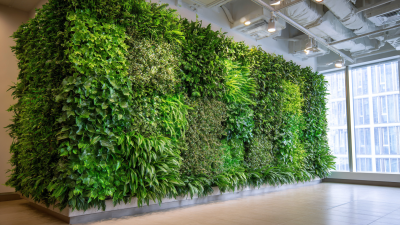Creating a Green Plant Wall at home is not only a trend but also a sustainable practice supported by a growing body of research. According to a report by the National Academies of Sciences, Engineering, and Medicine, indoor plants can improve air quality by removing toxins and increasing humidity, contributing to better mental and physical health. Moreover, the Global Greenhouse and Indoor Plant Market Report indicates that the indoor plant market is expected to grow significantly, reflecting a surge in consumer interest for greenery and eco-friendly designs in living spaces. With a well-designed Green Plant Wall, homeowners can effectively enhance their living environment while reaping the numerous benefits of nature. This essential checklist will guide you through the process of creating your own Green Plant Wall, ensuring you have the right plants, materials, and maintenance strategies to thrive in your urban oasis.

When embarking on the journey of designing your own green plant wall, avoiding common pitfalls can save you time, money, and frustration. One of the most significant mistakes is failing to select the right plants for your specific environment. Not all plants thrive in the same conditions, and factors such as light exposure, humidity, and temperature should guide your choices. Researching plant varieties that flourish in your home’s conditions is crucial, as selecting the wrong species can lead to wilting and premature death, ruining your efforts.
Another common misstep is neglecting to consider the irrigation system. A plant wall demands consistent hydration, and overlooking proper watering techniques can spell disaster for your green design. Whether you choose to incorporate a drip irrigation system or opt for a manual approach, ensure that your plants receive adequate moisture without becoming waterlogged. It’s also essential to think about placement; a plant wall located too close to heating vents or in direct sunlight without protection can lead to uneven growth and stress on the plants. Planning these aspects carefully can lead to a flourishing and vibrant green wall in your home.
| Dimension | Details |
|---|---|
| Plant Selection | Choose plants that thrive in vertical arrangements like ferns, succulents, and pothos. |
| Watering System | Install a proper irrigation system to avoid over or under-watering issues. |
| Light Requirements | Ensure the wall is in a location that receives adequate light according to plant needs. |
| Maintenance Plan | Create a regular schedule for pruning, watering, and checking for pests. |
| Material Selection | Use lightweight and breathable materials for the base of the wall. |
| Design Layout | Plan the layout to create visual interest and diversity in plant heights. |
| Space Constraints | Make sure to consider the space available and room for plant growth. |
| Common Mistakes | Avoid overcrowding plants, neglecting light needs, and inconsistent maintenance. |
Creating a vertical garden at home can be a rewarding endeavor, but choosing the right plants is crucial for ensuring your green wall thrives. Experts recommend selecting plants that not only suit your indoor climate but also have complementary growth habits. According to a report by the American Society of Landscape Architects, plants such as pothos, ferns, and philodendrons are ideal for vertical gardens due to their easy maintenance and ability to adapt to varying light conditions.

Moreover, understanding the light exposure in your chosen space is essential. A study published in the Journal of Environmental Horticulture indicates that many common houseplants require different levels of light—while some thrive in bright indirect light, others prefer low-light environments. For example, snake plants and peace lilies are excellent choices for darker spaces, whereas herbs like basil and mint flourish in sunnier spots, making them perfect candidates for an edible green wall.
Lastly, consider the layout and aesthetic of your plant wall. Research from the Vertical Farm Project suggests incorporating a variety of textures and colors can enhance visual appeal and biodiversity, ultimately leading to a healthier micro-ecosystem. Mixing trailing plants with upright varieties can create dynamic layers, contributing to both the beauty and functionality of your vertical garden.
Creating your own green plant wall at home is an exciting way to enhance your living space with a touch of nature. To kick off this project successfully, it’s crucial to gather the essential tools and materials needed for a seamless installation. Begin with a sturdy framework to support your plant wall—choose between wire grids, wooden panels, or specialized wall planters. Additionally, you'll need high-quality potting soil, which is vital for ensuring that your plants receive the nutrients they need to thrive.
Before diving into your project, consider the types of plants you want to use. Opt for greenery that suits your home's lighting conditions, whether it's bright, indirect light or a shadier spot. Incorporate a variety of textures and colors to create an eye-catching display. Don't forget to invest in a good watering system; self-watering planters can save you time and ensure your plants stay hydrated.
Tip: When selecting pots or containers, make sure they have drainage holes to prevent overwatering. This is crucial for plant health. Also, arranging your plants by size will give your wall depth and dimension, making it an even more striking feature in your home.
Creating a thriving vertical garden requires a deep understanding of the care needs of the plants you choose to incorporate. Selecting the right plants is crucial; consider hardy varieties that flourish in various light conditions, such as pothos, ferns, or philodendrons. Make sure to group plants with similar care requirements together to simplify maintenance and ensure that all plants thrive.
 Lighting plays a vital role in plant health. Ensure your plant wall receives adequate light by placing it in a well-lit area or supplementing with grow lights if necessary. Regularly evaluate how much light each section of your wall gets and adjust the plant arrangements accordingly. Additionally, proper watering is essential; many plants in a vertical garden have different moisture needs. Implement a routine and use self-watering systems or moisture meters to avoid over- or under-watering.
Lighting plays a vital role in plant health. Ensure your plant wall receives adequate light by placing it in a well-lit area or supplementing with grow lights if necessary. Regularly evaluate how much light each section of your wall gets and adjust the plant arrangements accordingly. Additionally, proper watering is essential; many plants in a vertical garden have different moisture needs. Implement a routine and use self-watering systems or moisture meters to avoid over- or under-watering.
Lastly, keep an eye on humidity and temperature levels. Many indoor plants thrive in environments with higher humidity, so using a humidity tray or misting the plants occasionally can be beneficial. Regularly check for pests and diseases, and be proactive in addressing any issues. With these tips in mind, your green plant wall can flourish beautifully, bringing a vibrant touch to your home.
Maintaining a green plant wall can bring a refreshing touch to your home, but it’s not without its challenges. One common issue is unpleasant odors that may arise from improperly managed plants. If your plant wall starts emitting strange smells, it could be due to decaying leaves or overwatering, leading to root rot. Regularly check for dead foliage and ensure proper drainage to maintain a healthy environment for your plants.
Additionally, maintaining the right humidity levels is crucial. A poorly maintained plant wall can lead to mold or mildew development, which can not only smell bad but also pose health risks. To prevent this, ensure your plant wall is well-ventilated and monitor moisture levels. By addressing these common maintenance issues, you can enjoy a vibrant and healthy green wall without the unwelcome odors that sometimes accompany it.
This bar chart illustrates the essential maintenance needs for a green plant wall at home. It highlights the recommended frequency for watering, light exposure, nutrient feeding, and pest inspection. Proper adherence to these guidelines can help ensure a healthy and thriving plant wall.












